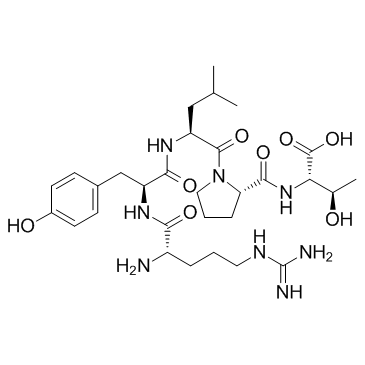57966-42-4
| Name | 2-[[1-[2-[[2-[[2-amino-5-(diaminomethylideneamino)pentanoyl]amino]-3-(4-hydroxyphenyl)propanoyl]amino]-4-methylpentanoyl]pyrrolidine-2-carbonyl]amino]-3-hydroxybutanoic acid |
|---|---|
| Synonyms |
Arg-tyr-leu-pro-thr
Proctolin |
| Description | Proctolin is an endogenous pentapeptide that acts as an excitatory neuromodulator. |
|---|---|
| Related Catalog | |
| In Vitro | Proctolin can increase the frequency of action potentials, increase the amplitude of muscle contraction, and initiate activity in quiescent systems[1]. In the arthropods, Proctolin acts as a neuromodulator and possibly as a neurohormone. It does not appear to function as a conventional neurotransmitter[2]. Proctolin is a pentapeptide with the mature peptide of RYLPT, and it is the first insect neuropeptide to be sequenced and chemically characterized. The first identification of a Proctolin precursor gene is CG7105 in D. melanogaster. Although a previous study showed that Proctolin is absent in B. mori, this pentapeptide is recently identified in a proteomic analysis of B. mori wings. However, the Bombyx Proctolin gene does not produce a mature peptide because cleavage sites are not present at the N-terminal and C-terminal of the RYLPT sequence, and a similar gene is observed in C. suppressalis. Therefore, a true Proctolin has been considered to be not observed in B. mori and C. suppressalis[3]. |
| References |
[2]. Orchard I, et al. Proctolin: a review with emphasis on insects. J Neurobiol. 1989 Jul;20(5):470-96. |
| Molecular Formula | C30H48N8O8 |
|---|---|
| Molecular Weight | 648.75100 |
| Exact Mass | 648.36000 |
| PSA | 283.76000 |
| LogP | 2.83220 |
| Storage condition | 2-8℃ |
